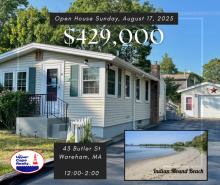Wareham Fire Department offers carbon monoxide safety tips
During the winter months, snow can create drifts that block exhaust vents, forcing carbon monoxide gas (CO) to backup into homes. High efficiency appliances and those with power-vent blowers waste less heat, causing low exhaust air temperatures which is too low to melt the snow in a plugged exhaust pipe or vent. Keep sidewall and direct vents clear of obstructions, driving snow and pushes to provide proper ventilation.
Carbon monoxide gas is produced whenever any fuel, such as gas, oil, kerosene, wood or charcoal is burned. Hundreds of people die accidentally each year from carbon monoxide poisoning caused by malfunctioning or improperly used fuel-burning appliances, making it the number one cause of poisoning deaths in the United States.
Carbon monoxide enters the lungs and blood where it competes with oxygen to be carried by red blood cells. Without oxygen the cells begin to die causing people to experience flu-like symptoms such as headache, dizziness, nausea, confusion and fainting. High levels of carbon monoxide exposure can cause unconsciousness or death.
If people suspect carbon monoxide exposure they should get out of the house and into fresh air, call the fire department from a cell phone or neighbor's house and seek medical help immediately if experiencing symptoms of carbon monoxide poisoning.
Homes should be equipped by carbon monoxide detectors that are approved and certified by a nationally recognized testing institute. Follow all installation instructions carefully and place them near bedrooms so family members will awaken at night and in places where people spend most of their time so they can be heard and seen. Do not place a detector in a garage, furnace room or near a stove or fireplace. Detectors should also be kept away from open windows or doors; excessively hot, cold or damp areas; and "dead-air" spaces such as corners of rooms and peaks of ceilings.
If appliances that burn fuel are properly maintained and used, the amount of carbon monoxide produced is usually not hazardous. Have a service technicians inspect your appliances annually, before the heating season to make sure they are safe. Also check vent pipes, flues and chimneys for leaks or blockages; never use a charcoal grill indoors; don't use a gas oven to heat your home; don't leave a vehicle running inside a garage, even if the door is open because fumes can build up quickly inside the home; don't sleep in any room with an un-vented gas heater; and never use gasoline-powered engines in enclosed spaces.
For more information contact the Wareham Fire Department at 508-295-2973.













